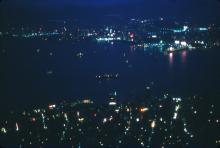CO 129 at TNA Kew
Primary tabs
One of the joys of life has been going to the National Archives in Kew and lugging a large CO 129 box back to ones desk. Opened up, the great tome of correspondence between Hong Kong and the Colonial Office in London is a treasure trove. Of course, there's the pages one's looking for - but there's always the unexpected, too. Is that a map folded up there? What's that about? Oh! an early underpass sceme! What's this letter? Wow! correspondence from Florence Nightingale! You get the drift - aside from the discoveries one can make, there's the physicality of seeing the actual signatures, the envelope that was sent 150 years ago, the doodle at the corner ... Well, everything has to change. I tried to book some volumes for this Saturday, but when I had problems made an enquiry. it seems that the whole series has now been digitised, in the interest of preservation. They are available for view on terminals in the building (there are plenty of them, so that's not an issue). In exceptional cases, if one can prove that digitisation has made a document illegible, volumes can be seen. I'l report back after Saturday as to how the system seems to work - hopefullly it will still give access to whole volumes, not just to specific pages, at any time. I'm going to take some files of my pictures taken in the past for comparison and see if they have included all the maps and charts, all the marginal notes etc etc. It will be interesting to see how easy they are to download to one's own storage. But I'm rather sad to find that I'm forced to look at a screen for hours rather than gently turn the page of these wonderful historic documents.


TNA ... reporting live ...
Reporting live from TNA, as it were ...
Three TNA staff advisers and about 45 mins and we had the new system for viewing CO 129 volumes running smoothly. Its been digitised by a company called Gale - the TNA don't have the money to digitise everything, so some, like this, get sold to external companies. The system isn't really intuitive - its easy enough refine the search to aboutl 2000, but then requires finding the advanced search on a very busy screen, sliding the field down to 'manuscript volume' and entering the desired number. Within the document, (and you get the whole volume, with a page select function) it moves quite quickly. Their page numbers are out of kilter with the ones printed on the documents, since they include the cover etc - but quick enough to flip through. Then pages (up to 200 at a time) can be downloaded, and transferred via googledocs or wetransfer etc. It seems to take a minute or so to download 4 pages, so doing big batches would be time consuming, but probably only the same as taking that many photos. The reproduction seems very good - I've not found a map there yet, but the charts and plans were really sharp, and text magnifies fine. So ... a cautious welcome for this. And the TNA do a splendid bacon sarnie these days!
CO129 and the Public Record Office
I was a very raw PhD student when I first set foot in the British archives, in 2001. What was then called The Public Record Office was in The Strand, I think, in an ancient pile with few of the facilities the modern estabilishment has. My intent was to read a whole lot of CO129 files, primarily about the 1898 treaty with China leasing the New Territories. My impression was that this great documentary source had been rarely consulted by other than government clerks. George B Endacott had used them though, I believe (but I don't now recall why I came to that belief), somewhat randomly. I came across James Hayes there, looking up some detail, I suspect in his private capacity. We had access to the original materials, not even photocopies or microfilm then seemed to be in use, at least for CO129. It was all a bit musty and old-fashioned, though I was able to see all I wanted to see at that time and I thrilled to the sense of historicity provided by the original documents. After the move to Kew the lot of researchers has greatly improved in some respects through digitisation and photography and so on, making the process more efficient though less romantic. I last returned two or three years ago, looking for material on legal aspects of the British attempt to discuss extending the New Territories lease, but anything of any importance was of course embargoed and probably still is. It's unlikely I'll be back. But I have warm memories of the process of research there, the camaraderie engendered, and the respect for old historical materials. Thank you Patricia for reminding me ...